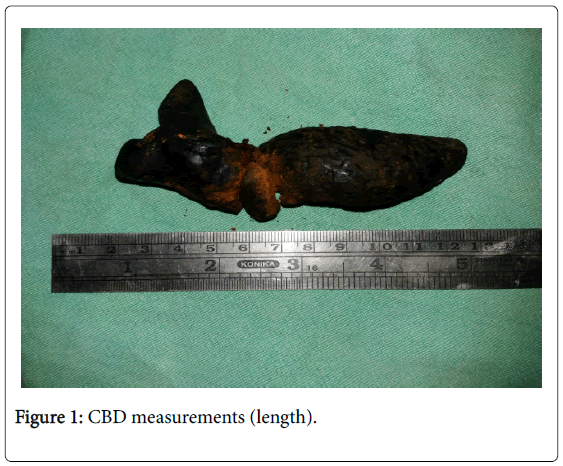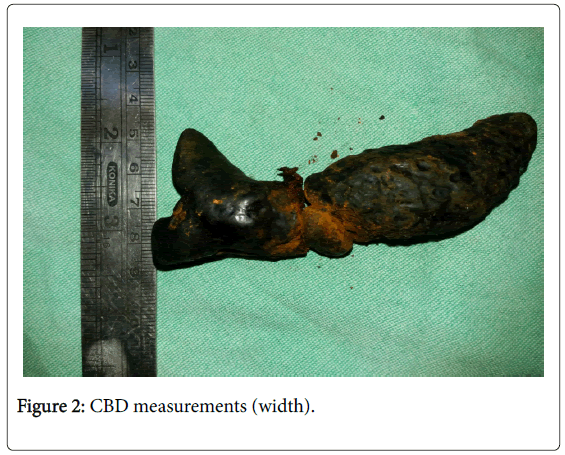Case Report Open Access
Giant Staghorn Common Bile Duct Calculus (A Case Report)
Javaid Bhat*Department of General Surgery, Sher-i-Kashmir Institute of Medical Sciences, Jammu Kashmir, India
- *Corresponding Author:
- Bhat J
Department of General Surgery, Sher-i-Kashmir Institute of Medical Sciences
Jammu Kashmir, India
Tel: +919419005579
E-mail: dr.skims1283@gmail.com
Received date: September 11, 2017; Accepted date: September 15, 2017; Published date: September 22, 2017
Citation: Bhat J (2017) Giant Staghorn Common Bile Duct Calculus (A Case Report). J Gastrointest Dig Syst 7:528. doi:10.4172/2161-069X.1000528
Copyright: © 2017 Bhat J. This is an open-access article distributed under the terms of the Creative Commons Attribution License, which permits unrestricted use, distribution, and reproduction in any medium, provided the original author and source are credited.
Visit for more related articles at Journal of Gastrointestinal & Digestive System
Abstract
Giant staghorn common bile duct (CBD) calculi are usually uncommon but can be found in patients with oriental cholangiohepatitis. The size of stone can vary from few millimetres to several centimetres. These are usually pigment stones and patients can present with pain, jaundice and fever or some times Reynold's pentad. Primary bile duct stones form within the bile ducts and usually are of brown pigment variety containing higher proportion of bilirubin as compared to cholesterol.
Bile infection appears to be the initial event leading to stone formation. The secondary CBD stones arise from gall bladder or intra and extrahepatic ducts. They are mostly cholesterol stones. We are presenting a case in which we removed a giant staghorn calculus from the CBD measuring 11.5 × 4 cm and weighing about 100 grams.
Keywords
Common bile duct; Staghorn; Cholesterol; Bilirubin; Bile duct stone
Introduction
Stones producing common bile duct (CBD) obstruction may arise in the CBD itself, in the gall bladder or in the intrahepatic or extrahepatic ducts. Primary bile duct stones form within the bile ducts and usually are of brown pigment variety containing higher proportion of bilirubin as compared to cholesterol. Bile infection appears to be the initial event leading to stone formation.
The secondary bile duct stones are mostly cholesterol stones (75%) and black pigment stones (25%). They are formed in the presence of cholesterol saturation, biliary stasis and nucleating factors. Cholesterol stone formation involves behavioural and biologic factors like nutrition, weight loss, obesity, physical activity and increasing age, female sex, parity and serum lipid levels. Black pigment stones are associated with haemolytic disorders, cirrhosis, ileal resection, prolonged fasting and total parenteral nutrition.
The size of an obstructing stone varies from a few millimetres in diameter to several centimetres. We are presenting a case in which we removed a giant staghorn calculus from the CBD measuring 11.5 × 4 cm and weighing 100 g.
Case Report
A 38 year old married Muslim female from Kishtwar J & K was admitted in Medical Gastroenterology department Sher-i-Kashmir Institute of Medical Sciences on 24th June 2015 with pain upper abdomen, vomiting and fever since 1 year. Examinations revealed an ill looking, averagely built patient with mild tinge of icterus.
The abdominal examination revealed tenderness and rigidity in right upper quadrant. On investigations haemoglobin was found to be 11.6 g%, and TLC of 8600/cumm, DLC of P-75%, L-23%, E-2%. Liver function tests showed serum bilirubin of 21 mg%, ALT- 78, ALP- 820, total protein 6.8 g%, albumin 3.4 g%. Urine analysis was normal. Plain ski gram of abdomen revealed no abnormality the X-ray chest was also normal. ECG was normal.
Coagulogram revealed PT 13.5, INR 1.15 and Aptt 24.0 Ultrasonography report showed dilated CBD (4 cm) with large calculus (10 cm) in the lumen. ERCP revealed a small parapapillary diverticulum. Cholangiogram showed a huge stone cast occupying whole CBD, dilated IHBR and ENBD was placed.
Patient was planned for surgical exploration and shifted to General Surgery ward. Repeat LFT after five of biliary drainage showed serum bilirubin of 6.8 mg%, ALT- 67, ALP- 220, total protein 7.2 g%, albumin 3.6 g%. On laprotomy, intraoperative findings revealed small GB which was thick walled, partly intrahepatic containing a solitary calculus (1 × 3 cm).
CBD and CHD (common hepatic duct) were grossly dilated (approx 4 cm) containing large calculus (11.5 × 4 cm) occupying the whole CBD, CHD and extending into right and left main hepatic ducts. ENBD (endonasal biliary drainage) catheter was in place. Left lobe liver was hypertrophied.
Stay sutures were placed and CBD was opened. Major portion of the stone was removed en mass but the portion which was adherent to the posterior wall of the duct was removed piecemeal with difficulty. Gall bladder was removed which contained a solitary calculus.
The CBD was closed over T-tube. The post-operative period was uneventful and patient discharged on 4th day of post-operative day. The CBD stone measured 11.5 × 4 cm and weighed 100 g (Figures 1 and 2).
The chemical analysis of the stone showed it to be composed of cholesterol, bilirubin and calcium. On follow-up patient showed improvement in nutrition and liver function tests and ultrasonography revealed decreased duct size. The cholangiogram was normal and Ttube was removed after 4 weeks.
Discussion
In most cases of choledocholithiasis a solitary calculus is found in CBD [1]. Walter and Snell reported a solitary stone in two thirds of their cases. There are few cases when two to six and rarely more stones are reported in CBD [2]. Mayo Robson and Dobson once counted 88 stones and Judd and Marshall, more than 100 [3-5]. In most cases, the stone lies towards the lower end of the CBD and some 10% are lodged in the ampulla.
The stones in the CBD are oval in shape and conforming to the long axis of the duct. The shape results from the adhesions of biliary debris [6]. Giant gall bladder stones one measuring 4 in circumference and another 6.5 long and 6 thick have been reported [7,8]. Ahmed MN reported a CBD stone measuring 8.5 × 3.5 cm and weighing 55 grams [9]. Bahuleyan reported a giant CBD calculus measuring 6.5 × 3 cm and weighing 40.5 grams in a 38 years old Muslim multipara woman [10].
References
- Arid I (1958) A comparison in surgical studies. (2nd edn), E & S Livingston Ltd., Edinburg and London p: 994.
- Walter, Snell (1990) Diseases of the gall bladder and bile ducts. W. B. Saunders Company, Philadelphia and London.
- Robson AWM, Dobson JF (1904) Diseases of the gall bladder and bile ducts. W. Wood and Company, London.
- Judd ES, Marshall JM (1980) Gall stones in ampulla of vater. J Amer Med Assoc 95: 1061-1064.
- Judd ES, Marshall JM (1931) Gall stones in the common bile duct. Arch Surg 23: 175-181.
- Sherlock S (1961) Gall stones and their complications. (2nd edn), Blackwell Scientific Publications, Oxford p: 657.
- Lichtman SS (1953) Diseases of the liver, gall bladder and bile ducts. (3rd edn), Lea and Febiger, Philadelphia p: 1198.
- Bockus HL (1965) Gastro-Enterology. (2nd edn), W. B. Saunders Company, Philadelphia, London and Toronto p: 954.
- Ahmed MN, Bhat DP, Zargar HU, Khan MM (1982) Giant common bile duct stone: A case report. J Postgrad Med 28: 233-234.
- Bahuleyan CK (1975) Giant common bile duct calculus. Ind J Surg 37: 82.
Relevant Topics
- Constipation
- Digestive Enzymes
- Endoscopy
- Epigastric Pain
- Gall Bladder
- Gastric Cancer
- Gastrointestinal Bleeding
- Gastrointestinal Hormones
- Gastrointestinal Infections
- Gastrointestinal Inflammation
- Gastrointestinal Pathology
- Gastrointestinal Pharmacology
- Gastrointestinal Radiology
- Gastrointestinal Surgery
- Gastrointestinal Tuberculosis
- GIST Sarcoma
- Intestinal Blockage
- Pancreas
- Salivary Glands
- Stomach Bloating
- Stomach Cramps
- Stomach Disorders
- Stomach Ulcer
Recommended Journals
Article Tools
Article Usage
- Total views: 5126
- [From(publication date):
October-2017 - Aug 29, 2025] - Breakdown by view type
- HTML page views : 4228
- PDF downloads : 898


